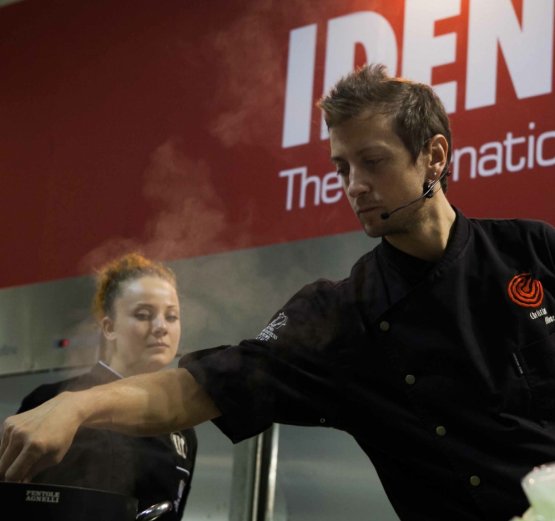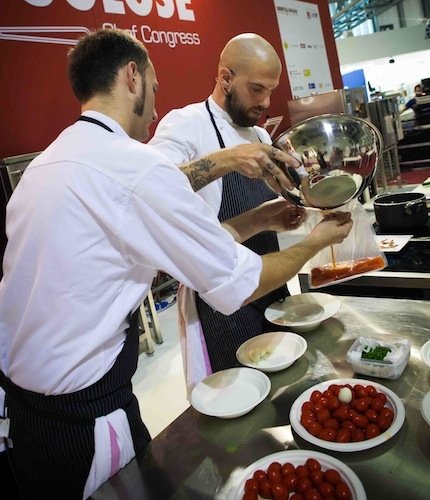Eugenio Roncoroni – at the helm of Al Mercato in Milan together with Beniamino Nespor – opens the second day at Cuochiduepuntozero within Host, together with Luca De Santi, his trusted pastry-chef. A restaurant with a unique soul and a double-concept, Al Mercato has a minuscule kitchen framed between two rooms: they offer street food in one room, and gourmet cuisine in the other. The challenge, therefore, is concentrating diabolical machinery into narrow spaces.
In Rho they re-interpret a Lobster club sandwich in a gourmet-style. This dish has some brave tastes and unites all the elements of a club sandwich and of a lobster roll, but de-structured, a trip away from bread. There are pork’s ears (a terrine that requires two days of work), one of the most recognisable signature dishes by Euge&Ben (with Sichuan pepper, sriracha sauce, brains…). The bacon is cooked between silpat sheets and powdered with an (improper use) of the Pacojet. The quail eggs are red because they are “pickled” (another fetish technique) at cold temperature for 2-3 days in the tandoori. The best technology? «Making mistakes: the best dishes are the result of an error».

Manuel and Christian Costardi, Cinzia in Vercelli
It’s the turn of brothers
Christian and
Manuel Costardi of restaurant
Cinzia in Vercelli, «two chefs who are successful with every dish and food category», says
Paolo Marchi when introducing them «but are mostly renown for their risotto because, truth be said, nobody can prepare it as they do». The proof is given by their new generation mushroom risotto, which is inspired by other worlds of gastronomy. “Inspiration” is the dimension by which we should be overwhelmed.
The risotto is made with mushrooms previously dried for 2 days in the drier and then put into a vacuum pack «in order to extract as much flavour as possible». This risotto is focused on «less is more»: there are no fats, there’s no frying, no wine («mushrooms already have their acid component»), no spices and a salt-less stock. «Rice is like a white canvas on which we can work as we like, it is ready to welcome all kinds of ingredients». Like a canvas by Van Gogh, had he passed through the rice-fields of Vercelli. This rice, however, needs to be eaten with a spoon.

Christian Milone, La Gastronavicella of Trattoria Zappatori in Pinerolo (Torino)
of
Trattoria Zappatori’s Gastronavicella in Pinerolo (Torino), an ex-professional cyclist, opens the way on the afternoon of day two. «I started at the age of 25 but I had to learn to stand on my feet first, because before that I either pedalled or slept». Once he learnt to keep silent, he first decided to transform the preparation of his parents’ Four cheeses gnocchi into a good pasta dish, full of taste but without the usual heaviness.
The cheese are all made with cows’ milk: a Piedmontese toma blu, Grana Padano matured 24 months and Seirass (the fourth is added at the end: it is the water removed) and they are put into a vacuum pack for 2 hours (plus 5-6 hours of rest), a trick that allows him to extract the taste of cheese, with the addition of tapioca flour to thicken the mixture. What pasta does he use? Rigatoni, because of their strong structure and their capacity to capture the sauce. The Sichuan pepper makes the cheese stand out, it takes the fat away and makes it cleaner. This is a 2.0 dish, «one which arrives at the table without embarrassing you». Technique is put at the service of flavour, which finally hides all the effort made.

Eugenio Roncoroni, Al Mercato, with Luca De Santi
The last speech is the most gracious one:
Sara Preceruti from Pavia, chef at
Locanda del Notaio in Pellio Intelvi (Como) for the past 3 years holds this lesson. The restaurant «is the less famous one-Michelin-starred restaurant in Italy», insists
Marchi. This is a new chapter in cooking at low temperature:
Lamb shin (the lamb is from New Zealand)
cooked at low temperature and aromatised with sage, rosemary and citrus zest. This method preserves the organoleptic characteristics, so much so that you can keep the lamb in the fridge for up to 3 weeks.
The lamb is breaded in the traditional way, with flour, eggs and breadcrumbs, and it is then fried in clarified butter, like a Milanese cutlet, and paired with a small jar of mustard. Next to it there’s some raw cabbage, which usually doesn’t go with meat. Here it goes perfectly, even in the form of decoration (dried on the silpat sheet).
THE NEXT COOKING CLASSES
Today
10-11 am Matias Perdomo
noon-1 pm Davide Scabin
2.30-3.30 pm Roy Caceres
4.30-5.30 pm Beniamino Nespor andd Eugenio Roncoroni
Monday October 21st
10-11 am Daniel Facen
noon-1 pm Sara Preceruti
2.30-3.30 pm Christian Milone
4.30-5.30 Christian and Manuel Costardi
Tuesday October 22nd
10-11 am Fabio Pisani
noon-1 pm Fabrizio Ferrari